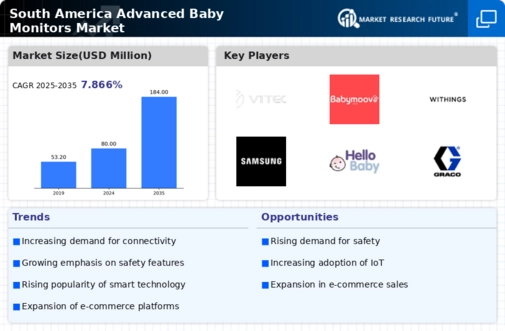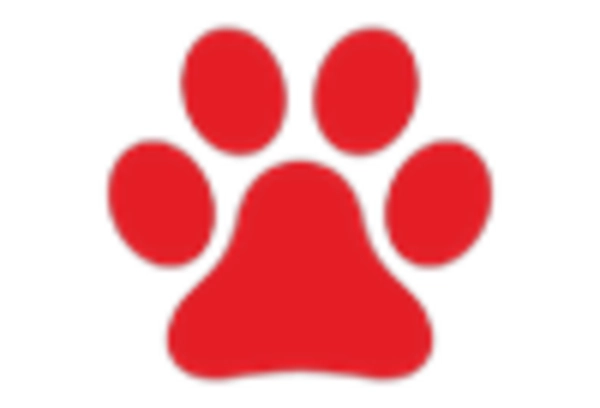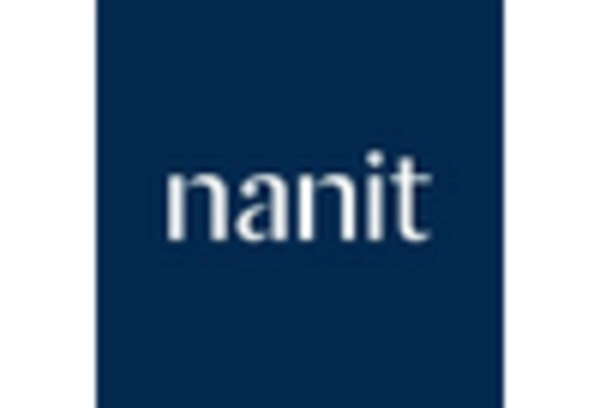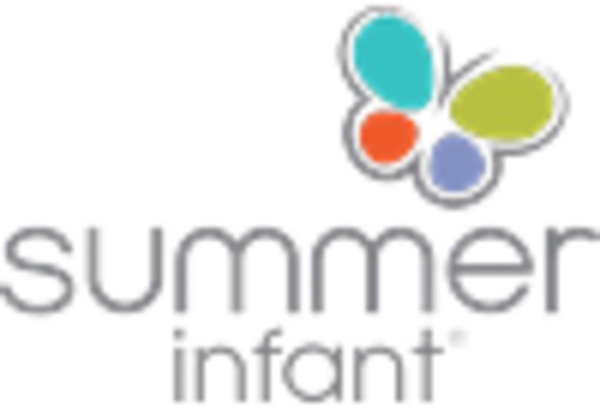Rising Disposable Income
The advanced baby-monitors market in South America appears to be positively influenced by the increasing disposable income among families. As economic conditions improve, more households are willing to invest in premium baby-monitoring solutions that offer advanced features. This trend is particularly evident in urban areas where families prioritize child safety and comfort. According to recent data, the average disposable income in South America has risen by approximately 15% over the past five years, enabling parents to allocate more funds towards high-quality baby products. Consequently, this financial flexibility is likely to drive demand for advanced baby-monitors, which often come with enhanced functionalities such as video streaming, temperature monitoring, and two-way communication. The growing middle class in countries like Brazil and Argentina further supports this trend, as these families seek to provide the best for their children.
Technological Advancements
Technological advancements play a crucial role in shaping the advanced baby-monitors market in South America. The integration of cutting-edge technologies such as artificial intelligence, machine learning, and IoT (Internet of Things) is transforming traditional baby-monitoring devices into sophisticated systems. These innovations allow for features like real-time alerts, sleep tracking, and remote access via smartphones. As consumers become more tech-savvy, their expectations for baby-monitoring solutions evolve, leading to a demand for products that offer seamless connectivity and enhanced functionalities. Market data indicates that the adoption of smart home devices in South America has increased by 25% in the last two years, suggesting a growing acceptance of technology in everyday life. This trend is likely to propel the advanced baby-monitors market, as parents seek devices that not only ensure safety but also provide valuable insights into their child's well-being.
Influence of E-commerce Growth
The advanced baby-monitors market in South America is experiencing a notable boost due to the rapid growth of e-commerce platforms. As online shopping becomes increasingly popular, parents are turning to digital channels to purchase baby-monitoring devices. This shift is driven by the convenience, variety, and competitive pricing offered by e-commerce retailers. Data suggests that online sales of baby products in South America have surged by 30% over the past year, indicating a significant change in consumer purchasing behavior. E-commerce platforms provide parents with access to a wide range of advanced baby-monitors, allowing them to compare features and prices easily. This trend is likely to enhance market penetration, as more consumers discover the benefits of purchasing baby-monitoring solutions online. The convenience of home delivery and the ability to read customer reviews further contribute to the appeal of e-commerce in this sector.
Growing Awareness of Child Safety
The advanced baby-monitors market in South America is significantly driven by the growing awareness of child safety among parents. As concerns regarding child safety and well-being rise, parents are increasingly seeking reliable monitoring solutions to ensure their children's security. This heightened awareness is reflected in the rising demand for advanced baby-monitors that offer features such as night vision, motion detection, and sound alerts. Recent surveys indicate that approximately 70% of parents in urban areas prioritize safety features when selecting baby-monitoring devices. This trend is likely to continue, as parents become more informed about the potential risks associated with child care. Consequently, manufacturers are responding by developing innovative products that cater to these safety concerns, thereby fueling growth in the advanced baby-monitors market. The emphasis on child safety is expected to remain a key driver in the coming years.
Increasing Focus on Parenting Education
The advanced baby-monitors market in South America is also influenced by the increasing focus on parenting education and resources. As parents become more educated about child development and safety, they are more likely to invest in advanced baby-monitoring solutions that align with their parenting philosophies. Workshops, online courses, and community programs are helping parents understand the importance of monitoring their children's well-being. This educational trend is reflected in the rising demand for products that offer comprehensive monitoring features, such as health tracking and sleep analysis. Market Research Future indicate that approximately 60% of new parents in South America actively seek information on child safety and development, which in turn drives their purchasing decisions. As awareness and education continue to grow, the advanced baby-monitors market is expected to benefit from a more informed consumer base that prioritizes quality and functionality.


















Leave a Comment